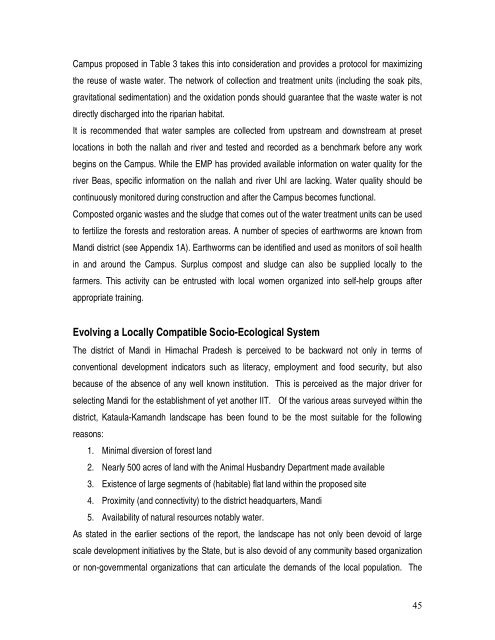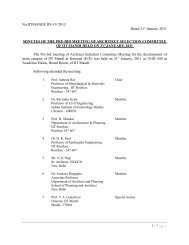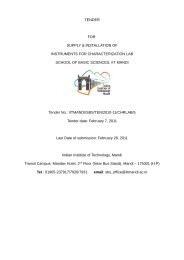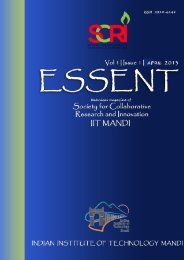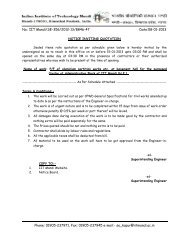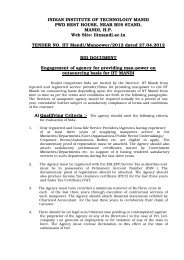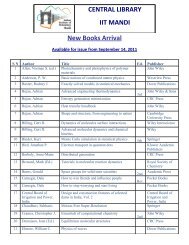Eco Report of the area - IIT Mandi
Eco Report of the area - IIT Mandi
Eco Report of the area - IIT Mandi
Create successful ePaper yourself
Turn your PDF publications into a flip-book with our unique Google optimized e-Paper software.
Campus proposed in Table 3 takes this into consideration and provides a protocol for maximizing<br />
<strong>the</strong> reuse <strong>of</strong> waste water. The network <strong>of</strong> collection and treatment units (including <strong>the</strong> soak pits,<br />
gravitational sedimentation) and <strong>the</strong> oxidation ponds should guarantee that <strong>the</strong> waste water is not<br />
directly discharged into <strong>the</strong> riparian habitat.<br />
It is recommended that water samples are collected from upstream and downstream at preset<br />
locations in both <strong>the</strong> nallah and river and tested and recorded as a benchmark before any work<br />
begins on <strong>the</strong> Campus. While <strong>the</strong> EMP has provided available information on water quality for <strong>the</strong><br />
river Beas, specific information on <strong>the</strong> nallah and river Uhl are lacking. Water quality should be<br />
continuously monitored during construction and after <strong>the</strong> Campus becomes functional.<br />
Composted organic wastes and <strong>the</strong> sludge that comes out <strong>of</strong> <strong>the</strong> water treatment units can be used<br />
to fertilize <strong>the</strong> forests and restoration <strong>area</strong>s. A number <strong>of</strong> species <strong>of</strong> earthworms are known from<br />
<strong>Mandi</strong> district (see Appendix 1A). Earthworms can be identified and used as monitors <strong>of</strong> soil health<br />
in and around <strong>the</strong> Campus. Surplus compost and sludge can also be supplied locally to <strong>the</strong><br />
farmers. This activity can be entrusted with local women organized into self-help groups after<br />
appropriate training.<br />
Evolving a Locally Compatible Socio-<strong>Eco</strong>logical System<br />
The district <strong>of</strong> <strong>Mandi</strong> in Himachal Pradesh is perceived to be backward not only in terms <strong>of</strong><br />
conventional development indicators such as literacy, employment and food security, but also<br />
because <strong>of</strong> <strong>the</strong> absence <strong>of</strong> any well known institution. This is perceived as <strong>the</strong> major driver for<br />
selecting <strong>Mandi</strong> for <strong>the</strong> establishment <strong>of</strong> yet ano<strong>the</strong>r <strong>IIT</strong>. Of <strong>the</strong> various <strong>area</strong>s surveyed within <strong>the</strong><br />
district, Kataula-Kamandh landscape has been found to be <strong>the</strong> most suitable for <strong>the</strong> following<br />
reasons:<br />
1. Minimal diversion <strong>of</strong> forest land<br />
2. Nearly 500 acres <strong>of</strong> land with <strong>the</strong> Animal Husbandry Department made available<br />
3. Existence <strong>of</strong> large segments <strong>of</strong> (habitable) flat land within <strong>the</strong> proposed site<br />
4. Proximity (and connectivity) to <strong>the</strong> district headquarters, <strong>Mandi</strong><br />
5. Availability <strong>of</strong> natural resources notably water.<br />
As stated in <strong>the</strong> earlier sections <strong>of</strong> <strong>the</strong> report, <strong>the</strong> landscape has not only been devoid <strong>of</strong> large<br />
scale development initiatives by <strong>the</strong> State, but is also devoid <strong>of</strong> any community based organization<br />
or non-governmental organizations that can articulate <strong>the</strong> demands <strong>of</strong> <strong>the</strong> local population. The<br />
45


